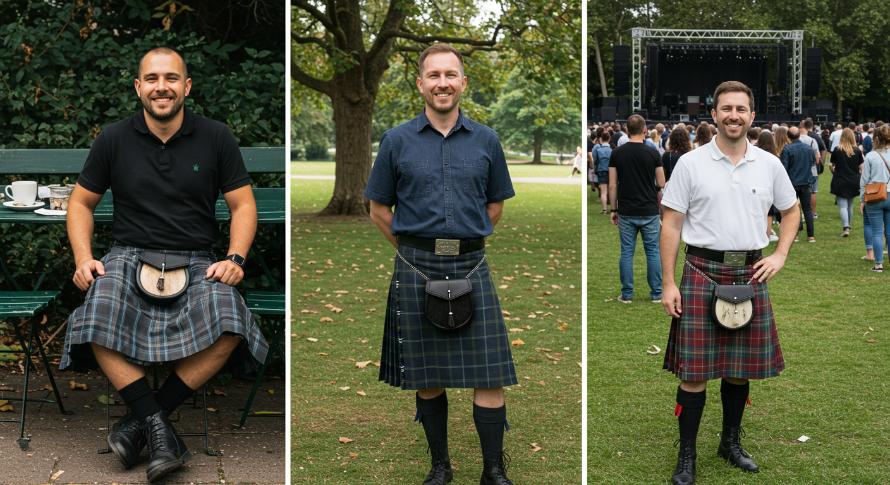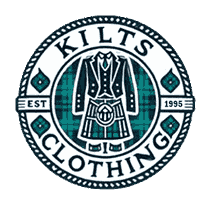The Evolution of Casual Kilts: From Traditional to Modern Styles

Kilts have long been a cultural emblem of Scotland, representing pride, identity, and craftsmanship. Their evolution from traditional Highland wear to modern men's casual kilts and also women attire highlights a fascinating blend of heritage and contemporary style. Over time, kilts have transformed from formal and ceremonial garments into everyday fashion statements, appealing to global audiences. This blog explores the historical roots of kilts, their cultural significance, and their adaptation into modern casual kilt wear.
Origins and Historical Roots of Kilts
As we recognize it today, the kilt traces its origins back to 16th-century Scotland. Initially, it was a full-length garment known as the "Great Kilt" or Feileadh Mor, which consisted of a large piece of cloth wrapped around the body and secured with a belt. Made from handwoven wool and featuring tartan patterns that symbolized different clans, the Great Kilt served both practical and symbolic purposes. It provided warmth in the chilly Highlands and was often worn during battle, making it a multifunctional attire.
By the 18th century, the Great Kilt evolved into the shorter, more practical version known as the small Kilt or Feileadh Beag, which resembles the kilts we see today. This adaptation began the kilt's association with formal events, military uniforms, and national pride.
The Shift Towards Casual Wear
The industrialization of the 19th century brought significant changes to clothing production, impacting traditional garments like kilts. During this period, kilts began to move beyond their role in Highland culture and ceremonial functions. As more Scots migrated to cities for work, the need for practical, everyday clothing increased.
At the same time, kilts became symbolic attire for formal gatherings, parades, and cultural celebrations. However, it wasn't until the late 20th century that designers and fashion enthusiasts began experimenting with kilts as casual wear. This transition was driven by a desire to adapt traditional garments to modern lifestyles, making them accessible and versatile.
The Cultural Relevance of Traditional Kilts Today
Despite their evolution, traditional kilts remain an essential part of Scottish heritage. They are commonly worn at weddings, graduations, and other formal occasions, symbolizing respect for cultural traditions. Family-specific tartans are still prominent, with many families maintaining ties to their ancestral patterns.
Additionally, traditional kilts are central to events like the Highland Games and military ceremonies, emphasizing their ongoing cultural significance. However, even in these conventional contexts, modern design elements have occasionally been incorporated to enhance comfort and functionality.
The Introduction of Modern Casual Kilts
Modern casual kilts emerged as a response to the growing interest in blending traditional fashion with contemporary aesthetics. These kilts prioritize comfort, practicality, and style, making them suitable for everyday wear. The shift began with utility kilts, which feature practical additions such as pockets, adjustable straps, and lightweight fabrics.
Designers also experimented with alternative materials, moving beyond wool to include cotton, denim, and synthetic fabrics. This innovation allowed for a broader range of styles, from rugged outdoor wear to sleek, urban fashion. Casual kilts became popular among various subcultures, including punk and streetwear enthusiasts, contributing to their growing global appeal.
Key Features of Modern Kilts
Modern kilts distinguish themselves through several innovative features:
- Materials: Unlike traditional kilts from heavy wool, modern kilts often use lightweight fabrics like cotton and polyester blends, providing enhanced breathability and comfort.
- Design: Contemporary kilts incorporate utility-focused designs with cargo-style pockets, belt loops, and adjustable waistbands.
- Versatility: Modern kilts are designed for various occasions, from casual outings to outdoor adventures. Utility kilts, hybrid kilts, and denim kilts offer unique options for different settings.
These features have expanded the kilt's appeal, making it a flexible garment that can be dressed up or down depending on the occasion.
Style Comparisons: Traditional vs. Modern
One of the key differences between traditional and modern kilts lies in their design and intended use. Traditional kilts feature clan-specific tartans and are meticulously tailored to maintain historical authenticity. They are typically reserved for formal settings and cultural events.
Modern kilts, on the other hand, prioritize functionality and adaptability. They often feature neutral or solid colors, minimalist designs, and practical enhancements such as pockets and durable fabrics. While traditional kilts require specific accessories like sporrans and ghillie brogues, modern kilts can be paired with a range of casual or sporty footwear.
Traditional Kilts:
- Wool fabric
- Clan-specific tartans
- Formal occasions and cultural events
Modern Kilts:
- Lightweight or synthetic fabrics
- Utility and minimalist designs
- Everyday wear and informal settings
The Global Influence of Casual Kilts
Kilts have transcended their Scottish origins, gaining recognition in global fashion and pop culture. Celebrities, musicians, and athletes have embraced kilts, showcasing them on red carpets, concert stages, and sporting events. This exposure has contributed to their popularity beyond Scotland, with people from diverse backgrounds adopting kilts as a fashion statement.
Subcultures such as punk rock have also played a significant role in popularizing casual kilts. Bands and fans have incorporated kilts to symbolize rebellion and individuality. Additionally, designers in the fashion industry have featured kilts in collections, blending traditional elements with avant-garde aesthetics.
Styling Tips for Modern Kilt Wearers
For those interested in incorporating kilts into their wardrobe, here are some styling tips:
- Casual Look: Pair a modern kilt with a graphic t-shirt, leather jacket, and sneakers for an edgy, streetwear-inspired ensemble.
- Smart-Casual: Combine a neutral-toned kilt with a button-down shirt, blazer, and loafers for a polished yet relaxed outfit.
- Outdoor Wear: Opt for a utility kilt with cargo pockets, a rugged flannel shirt, and hiking boots.
Accessories like belts, sporrans, and socks can add depth to the outfit. Still, modern kilts allow for more flexibility, making them easy to style in creative ways.
Sustainability and Ethical Considerations
As the popularity of kilts grows, so does the importance of sustainable and ethical production practices. Traditional kilts are often handcrafted by skilled artisans, preserving traditional methods and ensuring high-quality craftsmanship. In contrast, some modern kilts are mass-produced using synthetic materials.
Consumers can make sustainable choices by supporting small businesses and using eco-friendly fabrics. Many contemporary designers adopt ethical practices, offering recycled or sustainably sourced kilts.
The Future of Casual Kilts
The future of kilts lies in their ability to balance tradition with innovation. Designers will experiment further with materials, patterns, and silhouettes as fashion trends evolve. Collaborations between traditional kiltmakers and modern fashion brands could produce new hybrid designs catering to diverse tastes.
Moreover, the growing emphasis on sustainability may drive the development of eco-friendly kilts that blend heritage with modern values. As kilts continue gaining international attention, they will remain a symbol of cultural pride and creative expression.
Conclusion
The evolution of kilts from traditional Highland wear to modern casual attire showcases their versatility and enduring appeal. While traditional kilts honor Scotland's rich heritage, modern kilts offer innovative designs that cater to contemporary lifestyles. Whether worn for formal events or everyday activities, kilts have successfully bridged the gap between tradition and modernity, making them a timeless fashion statement.


